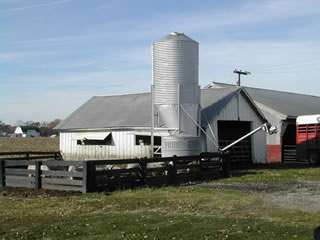|
 Agriculture Agriculture
Hoosiers began farming in the early 1800s, soon
after discovering how rich the soil was for planting. Forests
were cleared and farmers sought profit by planting corn and
wheat and eventually raising cattle, oxen, horses and swine.
Farming was the major cause of deforestation
in Indiana in the 1800s, as the land was cleared one tree
at a time. Out of the twenty-three million acres of natural
land, six million acres were destroyed for farmland. Pioneers
farmers used axes to cut down trees three feet or more in
diameter, but for very large trees—up to ten feet in
diameter—they used a technique called "girdling."
That is, they removed a ring of bark, causing the tree to
die. With no leaves blocking the sun, the soil could be planted.
Cropland in Indiana is increasing but farmers
are fighting to keep the growth steady. Because of urban
sprawl, farmers are facing the problem of people wanting
to move from the city to the county. This causes farmland
to be used for subdivisions, shopping centers, and other industrial
uses. By 2002, the rapid population growth and need for more
housing developments had created a huge problem for farmers
who are trying to plant and raise livestock. Although urban
sprawl is not a new problem, farmers are still suffering from
this predicament.
In addition to urban sprawl, farmers face the
difficulty of keeping their farmland when soil erosion happens.
Soil erosion causes the soil to
lose its nutrients and makes the land unfit to farm on. To
avoid this problem, most farmers transform the land with heavy
slopes, which are in danger of soil erosion, into pasture
for their livestock. Additionally they rotate crops, to keep
the nutrients in the soil and make sure the land will always
be useful for crops.
At present, Indiana remains a major producer
of crops. Indiana is the fifth largest producer of corn in
the United States. Corn is still used primarily for feeding
livestock, as it was during the 1800s. Wheat also continues
to be a major source of income. In pioneer times, wheat was
much easier to farm because it did not require
as much intense cultivation as corn. Presently, wheat
has dropped to the number three slot in crop production and
soybeans have taken its place as the second largest produced
crop in Indiana.
Some of the environmental issues that farmers
face in 2002 are biological, chemical, and nutrient runoff.
E. coli contamination, a result of biological runoff, arises
from poor manure management planning and is most often associated
with large "factory" farms. When manure from farms
pollutes lakes and
rivers, little can
be done once the water is polluted
with E. coli. Water treatment can be a partial solution, but
a very expensive one.
When farmers treat their crops with pesticides
to prevent insects from destroying their crops, chemical runoff
becomes an issue. Although DDT, perhaps the most notorious
of all pesticides to be used in the United States, was outlawed
in 1972, other pesticides even more toxic have come onto the
market. In 1995, according to the National Campaign for Pesticide
Policy Reform, 1.2 billion pounds of pesticides were used
in U.S. agriculture. The good news is that new pesticides
are becoming available that lose their toxicity over time,
but newer pesticides tend to be more expensive as well. Ultimately,
the potential danger of pesticide runoff is determined by
the farmer who controls the land.
Although crops are a primary focus in Indiana,
livestock is also a very important part of Indiana’s
agriculture. Around the 1850s, farmers discovered the profit
swine could bring them. Pigs were an excellent source of meat
and provided lard. Swine are a large part of farming because
their white meat is healthier than beef. However, cattle remain
a major part of farming, not only because of their beef, but
also because of their milk.
Indiana’s agriculture has come a long
way from the nineteenth century, but farmers continue to have
the same worries and values as farmers from the past. The
worry of floods, the right seeds to plant and the health of
both the land and their animals are constant worries to farmers.
Sources:
Brunswick, Kenneth. Telephone interview.
21 November 2002.
Conner Praire. "Indiana Farming:
Yesterday and Today.” 21 October 2002 <http://www.connerprairie.org/historyonline/indag.html>.
Gore, Al. Introduction. Silent
Spring. Rachel Carson. New York: Houghton Mifflin, 1994:
xv-xxvi.
Madison, James. H. The Indiana
Way: A State History. Bloomington: IU Press, 1986.
State of Indiana. Office of the Commissioner
of Agriculture. “Indiana Agriculture.” 13 October
2002 <http://www.in.gov/oca>.
|




